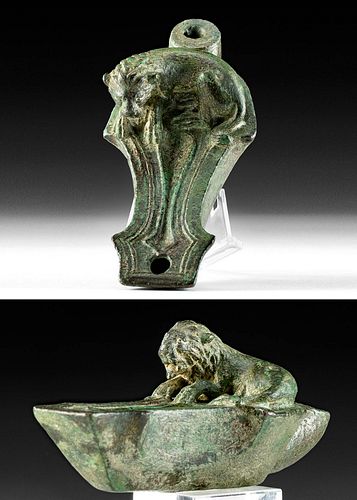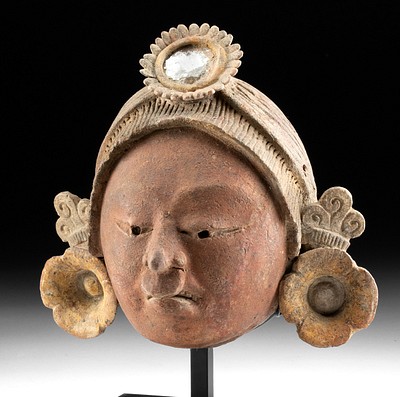Published & Exhibited Roman Bronze Oil Lamp with Lion
Lot 28
About Seller
Artemis Fine Arts
686 S Taylor Ave, Ste 106
Louisville, CO 80027
United States
Selling antiquities, ancient and ethnographic art online since 1993, Artemis Gallery specializes in Classical Antiquities (Egyptian, Greek, Roman, Near Eastern), Asian, Pre-Columbian, African / Tribal / Oceanographic art. Our extensive inventory includes pottery, stone, metal, wood, glass and textil...Read more
Estimate:
$10,000 - $15,000
Absentee vs Live bid
Two ways to bid:
- Leave a max absentee bid and the platform will bid on your behalf up to your maximum bid during the live auction.
- Bid live during the auction and your bids will be submitted real-time to the auctioneer.
Bid Increments
| Price | Bid Increment |
|---|---|
| $0 | $25 |
| $300 | $50 |
| $1,000 | $100 |
| $2,000 | $250 |
| $5,000 | $500 |
| $10,000 | $1,000 |
| $20,000 | $2,500 |
| $50,000 | $5,000 |
| $100,000 | $10,000 |
| $200,000 | $20,000 |
About Auction
By Artemis Fine Arts
Jul 14, 2022
Set Reminder
2022-07-14 10:00:00
2022-07-14 10:00:00
America/New_York
Bidsquare
Bidsquare : Exceptional Antiquities Ethnographica Fine Art
https://www.bidsquare.com/auctions/artemis-gallery/exceptional-antiquities-ethnographica-fine-art-9692
Museum-worthy examples of classical antiquities (Egyptian, Greek, Roman, Near Eastern), Viking, Far East / Asian, Pre-Columbian, African / Tribal, Oceanic, Native American, Spanish Colonial, Fossils, Ancient Jewelry, Fine / Visual Arts, so much more! Artemis Fine Arts info@artemisgallery.com
Museum-worthy examples of classical antiquities (Egyptian, Greek, Roman, Near Eastern), Viking, Far East / Asian, Pre-Columbian, African / Tribal, Oceanic, Native American, Spanish Colonial, Fossils, Ancient Jewelry, Fine / Visual Arts, so much more! Artemis Fine Arts info@artemisgallery.com
- Lot Description
Roman, Imperial Period, ca. 1st century CE. A stupendous leaded bronze oil lamp, cast via the lost wax (cire perdue) process, with an elegant, elongated body, a trapezoidal spout, and a magnificent high relief (nearly in the round) lion reclining in front of the filling aperture. The wild feline's anatomy, realistic pose, and features including a voluminous mane, perky ears, leering eyes, roaring mouth, sharp claws, and curled tail - are expertly delineated. In the classical world, lions symbolized power, wealth, and might. They were famously featured in many ancient myths, perhaps the most famous being that of Hercules (Herakles) slaying the Nemean lion for his first labor. Lions were also favorite iconography for buildings, coins, and statues. Size: 4.875" L x 2.125" W (12.4 cm x 5.4 cm)
Oil lamps such as this were filled with olive oil, had a wick placed inside the spout, and were used to light homes, shops, holy places, and many other locations throughout the Roman world. Oil lamps were certainly among the most ubiquitous objects in antiquity; however, finely crafted examples like this one were more unusual. Despite the prevalence of terracotta lamps, bronze oil lamps are among some of the rarest artifacts to come from the Roman Empire. Their scarcity, however, is a reminder of how everyday life would have been for the people who used them. Bronze examples like this were only affordable to upper class households due to the inherent cost and time associated with the processing, refinement, and ultimately casting of bronze. This particular example is much finer than the average, with its meticulous attention to detail and sturdy composition, and was probably created for and belonged to a member of the Roman elite who would have passed it down as a family heirloom.
Published: J. Eisenberg, Art of the Ancient World, vol. IV (1985), no. 321.
Exhibited at Parker Art Gallery, Colgate University; George Mason University; Fitchburg Art Museum, 1985 to 2011.
Provenance: private Curran, Michigan collection; ex private English collection; ex D. L. M. collection, Lincoln Park, Michigan USA, acquired from Royal Athena in 1985; Exhibited at Parker Art Gallery, Colgate University; George Mason University; Fitchburg Art Museum, 1985 to 2011. Published: J. Eisenberg, Art of the Ancient World, vol. IV (1985), no. 321.
All items legal to buy/sell under U.S. Statute covering cultural patrimony Code 2600, CHAPTER 14, and are guaranteed to be as described or your money back.
A Certificate of Authenticity will accompany all winning bids.
PLEASE NOTE: Due to recent increases of shipments being seized by Australian & German customs (even for items with pre-UNESCO provenance), we will no longer ship most antiquities and ancient Chinese art to Australia & Germany. For categories of items that are acceptable to ship to Australia or Germany, please contact us directly or work with your local customs brokerage firm.
Display stands not described as included/custom in the item description are for photography purposes only and will not be included with the item upon shipping.
#160872Collection number handwritten on underside. Minor surface wear commensurate with age with surface nicks to underside and peripheries of spout and body. Minor softening to details, but these are still quite strong. Beautiful patina of rich blue-green hues.Condition
- Shipping Info
-
All shipping is handled in-house for your convenience. Your invoice from Artemis Gallery will include shipping calculation instructions. If in doubt, please inquire BEFORE bidding for estimated shipping costs for individual items.
-
- Buyer's Premium



 EUR
EUR CAD
CAD AUD
AUD GBP
GBP MXN
MXN HKD
HKD CNY
CNY MYR
MYR SEK
SEK SGD
SGD CHF
CHF THB
THB
















